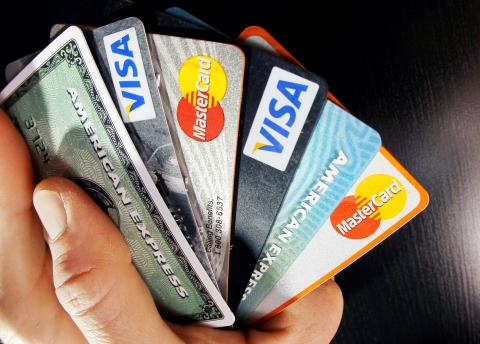With more and more local consumers keen to use credit cards, spending through the system in Taiwan hit a record high last year, the Financial Supervisory Commission (FSC) said on Friday.
Citing statistics, the commission said that consumers in Taiwan spent a total of NT$2.2 trillion (US$65.67 billion) using credit cards last year, up 7.9 percent from a year earlier.
It was the sixth consecutive year in which Taiwanese credit card purchases hit a record high, the commission said. However, the year-on-year growth in credit card spending for last year was lower than in the previous two years, when the annual increase surpassed 8 percent, the commission said.

Photo: AP
In December last year, consumers in Taiwan spent NT$204.3 billion through credit cards, the third-highest after the NT$242.5 billion seen in June last year and the NT$206.3 billion recorded in June 2014, the commission said.
The commission said that the spike reflected a buying spree in the month, while local consumers became more willing to pay for their insurance policies via credit card, giving another boost to December spending by NT$19.4 billion from November.
The commission said that although the local economy has shown signs of slowing, Taiwanese spending via credit card bucked the trend and continued to increase last year.
As of December, the number of valid credit cards issued by 36 authorized banks totaled 23.36 million in Taiwan, while the number of cards in circulation had hit 38.52 million, the commission said.
Meanwhile, electronic payments rose 20.69 percent last year from a year earlier to NT$64.6 billion, at a time when many local consumers tended to make their small-amount payments through so-called third-party payment instruments such as EasyCard and other registered prepaid cards, the commission said.
EasyCard (悠遊卡) is the largest third-party payment tool in Taiwan. As of the end of December, the number of EasyCards circulating in Taiwan totaled 47.27 million, accounting for almost 70 percent of the 68.89 million third-party payment instruments in the country, the commission said.
The statistics show that each person in Taiwan owned about two EasyCards on average as of the end of last year.
Other third-party payment instruments in Taiwan include iPass (一卡通), iCash (愛金卡) and HappyCash (遠鑫卡).
Meanwhile, more than half of Taiwanese say they feel money is tight and they may not have enough funds before the Lunar New Year holiday, according to a survey conducted recently by online job bank yes123.
The survey also found that more than 60 percent of respondents feel that they need to take on extra jobs to gain extra money.
The survey conducted by yes123 showed that people mainly rely on part-time jobs for extra cash (62 percent), followed by borrowing from relatives (39.2 percent), borrowing from colleagues (29.5 percent), credit loans from banks (27.1 percent) and salary advances from companies (21.7 percent).
The questionnaires were asked between Dec. 22 and Jan. 3. A total of 1,292 effective samples were collected with a margin of error of 2.73 percentage points.

The US dollar was trading at NT$29.7 at 10am today on the Taipei Foreign Exchange, as the New Taiwan dollar gained NT$1.364 from the previous close last week. The NT dollar continued to rise today, after surging 3.07 percent on Friday. After opening at NT$30.91, the NT dollar gained more than NT$1 in just 15 minutes, briefly passing the NT$30 mark. Before the US Department of the Treasury's semi-annual currency report came out, expectations that the NT dollar would keep rising were already building. The NT dollar on Friday closed at NT$31.064, up by NT$0.953 — a 3.07 percent single-day gain. Today,

‘SHORT TERM’: The local currency would likely remain strong in the near term, driven by anticipated US trade pressure, capital inflows and expectations of a US Fed rate cut The US dollar is expected to fall below NT$30 in the near term, as traders anticipate increased pressure from Washington for Taiwan to allow the New Taiwan dollar to appreciate, Cathay United Bank (國泰世華銀行) chief economist Lin Chi-chao (林啟超) said. Following a sharp drop in the greenback against the NT dollar on Friday, Lin told the Central News Agency that the local currency is likely to remain strong in the short term, driven in part by market psychology surrounding anticipated US policy pressure. On Friday, the US dollar fell NT$0.953, or 3.07 percent, closing at NT$31.064 — its lowest level since Jan.

Hong Kong authorities ramped up sales of the local dollar as the greenback’s slide threatened the foreign-exchange peg. The Hong Kong Monetary Authority (HKMA) sold a record HK$60.5 billion (US$7.8 billion) of the city’s currency, according to an alert sent on its Bloomberg page yesterday in Asia, after it tested the upper end of its trading band. That added to the HK$56.1 billion of sales versus the greenback since Friday. The rapid intervention signals efforts from the city’s authorities to limit the local currency’s moves within its HK$7.75 to HK$7.85 per US dollar trading band. Heavy sales of the local dollar by

The Financial Supervisory Commission (FSC) yesterday met with some of the nation’s largest insurance companies as a skyrocketing New Taiwan dollar piles pressure on their hundreds of billions of dollars in US bond investments. The commission has asked some life insurance firms, among the biggest Asian holders of US debt, to discuss how the rapidly strengthening NT dollar has impacted their operations, people familiar with the matter said. The meeting took place as the NT dollar jumped as much as 5 percent yesterday, its biggest intraday gain in more than three decades. The local currency surged as exporters rushed to